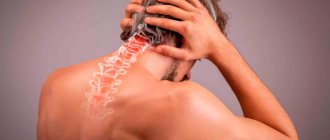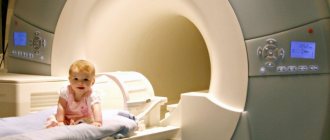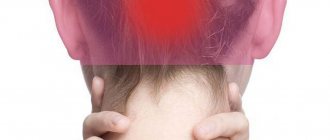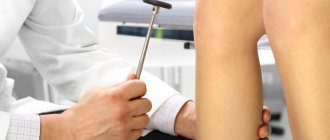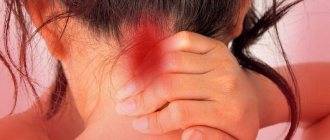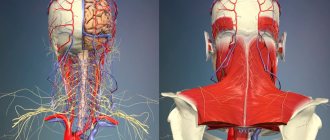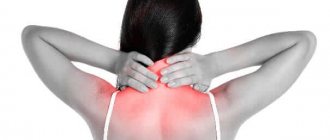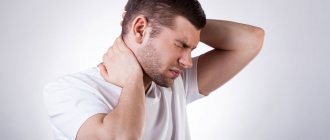Throbbing pain in the back of the head can be associated with both vascular pathologies and diseases of the spinal column and surrounding tissues. In both cases, immediate assistance from a neurologist is required. A specialist will be able to identify the exact cause and eliminate its further impact. This will prevent the risk of serious complications, such as ischemic stroke of the brain.
Therefore, if you have a throbbing pain in the back of your head, then try to get an appointment with an experienced specialist as soon as possible. In Moscow, you can make an appointment right now for a free appointment with a neurologist or vertebrologist at our manual therapy clinic. An experienced doctor will conduct a full examination, give you an accurate diagnosis and tell you how to carry out correct and effective treatment.
In the meantime, we suggest finding out more information about why this unpleasant symptom occurs and what structures can be damaged. To understand, you need to have an understanding of basic anatomy and physiology. The skull consists of several bones, including the occipital bone. Inside the skull is the brain. This is the central nervous system, which is responsible for rational duration, intelligence, and the functioning of all systems and organs of the human body. Here are the most important centers, major nerves, etc. Any damage to the brain can lead to very serious consequences. Therefore, it is reliably protected by the bones of the skull.
In the area of the occipital bone there is an opening through which the brain communicates with the spinal cord using cerebrospinal fluid. In this way, nerve impulses are transmitted and the work of the autonomic nervous system is coordinated.
The occipital bone borders the first cervical vertebra (atlas). It connects to the second cervical vertebra with a joint. There is no cartilaginous intervertebral disc between them. Between all subsequent cervical vertebrae, intervertebral discs are present.
On the sides of the cervical vertebrae there are additional uncovertebral (hook-shaped) processes. They form two channels. The posterior vertebral arteries pass inside. These are blood vessels emerging from the thoracic cavity in the area of the 6-7 cervical vertebrae. They are responsible for the blood supply to the posterior structures of the brain, vestibular apparatus, auditory and optic nerves.
The vertebral bodies of the cervical spine, together with the arcuate processes, form the spinal canal. Inside is the spinal cord, covered in hard, arachnoid and soft membranes. Paired radicular nerves arise from that structure. They branch, form regional nerve plexuses, and are responsible for the innervation of the neck, throat, larynx, thyroid gland, upper chest, upper limbs, and scalp.
Paired cranial nerves also arise from the skull. Some of them form the vagus nerve, the solar plexus. They are responsible for the innervation of the heart muscle, pacemaker, diaphragm, etc. Therefore, any pinching of paired cranial nerves provokes serious health problems.
It is very important not to self-diagnose and treat. The causes of throbbing pain in the back of the head can be very serious. It is very difficult to subjectively assess your condition, much less make a diagnosis. Therefore, we strongly recommend that you consult a doctor promptly. This could be a vertebrologist or a neurologist.
In Moscow, we invite you to a free appointment with a vertebrologist and neurologist at our manual therapy clinic. Experienced doctors work here. They will be able to provide you with all the help you need. They will make an accurate diagnosis and develop an individual course of effective treatment.
Sign up for a time convenient for your visit. To do this, just call the phone number indicated on the page or fill out the registration form located at the end of the page.
Causes of pain
Pain in the back of the head can be caused by injury: a blow or a fall. But patients usually know about this. It can also be caused by prolonged stress, incorrect head position while sitting and excessive physical activity. This symptom is typical for people who work at computers or at a desk.
Among the pathological causes of pain in the back of the head are:
- diseases of the nervous system;
- pathologies of the heart and blood vessels;
- damage to the jaw apparatus;
- infectious diseases.
To establish the exact cause, an additional examination is required, which is prescribed by a doctor.
Pain at the base of the skull
Rheumatism
Arthritis
28636 11 February
IMPORTANT!
The information in this section cannot be used for self-diagnosis and self-treatment.
In case of pain or other exacerbation of the disease, diagnostic tests should be prescribed only by the attending physician. To make a diagnosis and properly prescribe treatment, you should contact your doctor. Pain at the base of the skull: causes of occurrence, what diseases it occurs with, diagnosis and treatment methods.
Definition
Pain at the base of the skull (vertebrogenic cervicocranialgia) is a pain syndrome localized in the cervico-occipital region, which can spread to the frontotemporal region and the eye area on the homolateral side. It has been proven that the source of pain can be the structures of the upper cervical spine. Typically, this is the level of the C1, C2 and C3 vertebrae, which includes joints, discs, ligaments and muscles. The lower cervical vertebrae, as a rule, play an indirect role in the formation of clinical symptoms of pain.
Pathological diseases of the cervical spine, which are accompanied by intense or aching pain, experts call “painful neck” syndrome.
The International Headache Society, 3rd revision (ICHD-3) recommended considering cervicogenic headache as secondary, arising due to changes in the cervical spine, including bone structures, intervertebral discs, and soft tissue structures, the pathology of which is often accompanied by pain in the cervical spine. neck. 70% of patients with pain in the cervical spine simultaneously experience headache, but only in 18% of cases is it considered a consequence of neck pain.
In the genesis of headaches in childhood and adolescence, functional disorders in the spinal motion segments of the cervical spine, in particular disorders in the structures of its upper cervical spine, play a significant role.
Types of pain at the base of the skull
Cervicogenic pain is indicated by differential features such as unilateral headache extending from the back of the head to the front, and evidence of involvement of the cervical spine. An attack of pain can be triggered by applying pressure to trigger points in the neck/occipital area or holding the neck in an awkward position. It is important that in some cases such pain has migraine-like features - a number of patients experience photo- and phonophobia, lacrimation, nausea, vomiting, which can sometimes be regarded as a manifestation of migraine.
Pain at the base of the skull is characterized by limited range of motion in the cervical spine, soreness of the neck muscles, changes in muscle tone, or a reaction to passive or active stretching. Usually the pain is combined with a functional block at the upper cervical level.
Injuries to the upper cervical spine due to tumors, fractures, infections, and rheumatoid arthritis can cause headaches that present clinically in the same way as cervicocranialgia. However, a feature of cervicogenic headache is that it is provoked by movements in the cervical spine, and after performing certain warm-up movements in the neck it can stop. Most often, such complaints are not associated with serious pathology, and the patient makes a full recovery.
Possible causes of pain at the base of the skull
Pain at the base of the skull is based on functional and organic changes in various anatomical structures of the cervical spine: joints, ligaments, fascia, muscles, nerves. The leading role is given to degenerative-dystrophic changes in the spine. However, there are only isolated indications of the role of functional disorders.
One of the main causes of neck pain is staying in a fixed position for a long time. Other causes of the disease include:
- osteochondrosis, spondyloarthrosis, spondylosis, uncovertebral arthrosis and other changes in the spine;
- neck injuries, injuries;
- sprains;
- intervertebral disc herniation;
- spondyloarthritis, rheumatoid arthritis.
A common cause of cervicogenic pain is inferior oblique muscle syndrome.
A spasmed muscle can compress the neurovascular bundle passing under it (segment of the vertebral artery with the periarterial sympathetic plexus, occipital nerves) - for this condition, the development of paresthesia in the scalp is typical, and sometimes there is pain when combing the hair. It has been observed that stimulation of the cervical structures causes pain, and anesthesia reduces it. Lately, doctors are increasingly talking about “text neck” syndrome, which develops in people who spend a lot of time reading texts from electronic devices (gadgets).
The head of an adult weighs about 5 kg - this is the weight the neck experiences in its normal position. When reading from gadget screens, the head is usually tilted: when tilted just 15°, the load on the spine increases to 12 kg, and when tilted 60° – up to 27 kg. As a result, posture changes, the intervertebral discs of the cervical spine suffer, muscles spasm, and pain occurs at the base of the skull.
The main manifestations of pain at the base of the skull include:
- frequent contraction of the neck muscles, convulsions;
- painful sensations when turning the head;
- noise in the head, sleep disturbance;
- pain in the cervical spine, radiating to the head;
- dizziness;
- constant tension in the neck and back of the head.
The presence of three to four signs should make the patient think about seeking medical help.
Which doctors should you contact if you experience pain at the base of the skull?
To determine the cause of the headache, you should contact a general practitioner or. The doctor will prescribe the necessary examination, determine the cause of the disease and prescribe treatment.
Diagnosis and examinations for pain at the base of the skull
The following diagnostic criteria are used to make a diagnosis:
- The causal relationship of headache with pathology of the cervical region is based on at least one of the following signs:
- clinical signs confirm that the source of pain is located in the neck;
- pain stops after diagnostic blockade of neck structures or nerve formations (with an adequate comparative study with placebo).
Using clinical, laboratory and/or neuroimaging methods, signs of disorder or damage in the cervical spine or soft tissues of the neck that are a reliable or possible cause of headache are determined:
- X-ray of the cervical region in several projections;
Diseases associated with the symptom
The reason why the back of the head hurts may be pathology. Diseases characterized by symptoms:
- neuralgia;
- cardiopsychoneurosis;
- hypertension;
- cervical osteochondrosis;
- migraine;
- cervical spondylosis;
- myositis - inflammation of the neck muscles;
- myogelosis;
- malocclusion;
- lymphadenitis is inflammation of the lymph nodes near the neck.
They can be detected using diagnostic tests, some tests and examinations.
Diagnostics
You can get rid of occipital pain in the head only after discovering the cause of its occurrence. For this purpose the following is carried out:
- inspection and palpation;
- general blood analysis;
- ECG;
- Ultrasound of the heart;
- Ultrasound of head and neck vessels;
- EEG;
- X-ray of the cervical spine.
If infection is suspected due to lymphadenitis, additional tests and examinations are prescribed in specialized institutions (anti-tuberculosis dispensary, dermatovenerological dispensary, infectious diseases hospital or department).
What to do with throbbing pain in the back of the head
If throbbing pain appears in the back of the head, you need to take a horizontal position with the head end slightly raised. Be sure to provide a flow of fresh air into the room where you are. A simple lack of oxygen in the inhaled air can provoke such an attack.
Then, if possible, blood pressure levels should be measured. If it is within the age norm for the patient, then you can independently visit a neurologist. If your blood pressure level is elevated, it is better to call an ambulance. In this way, you may experience a developing hypertensive crisis.
Severe throbbing pain in the back of the head does not appear just like that. It has certain prerequisites. Most often these are the following types of negative impacts:
- prolonged stay in a static position with tension in the muscles of the neck and collar zone (spasm of cerebral blood vessels occurs and oxygen starvation of brain structures develops);
- improper organization of sleeping and working spaces in violation of modern ergonomic requirements;
- wearing tight and uncomfortable clothes;
- driving a car without wearing a seat belt;
- smoking and drinking any alcoholic beverages;
- curvature of the spine and poor posture;
- overweight and obesity.
The first thing to do if throbbing pain in the back of the head appears is to exclude, if possible, the effects of all potential causes of the development of pathologies of the blood vessels and the musculoskeletal system (spine, ligaments, tendons and muscles). To carry out a comprehensive diagnosis, it is best to visit a neurologist. He will conduct a full examination and make a preliminary diagnosis. Then additional examinations will be prescribed to clarify the diagnosis. This can be MRI of the brain and cervical spine, ultrasound of the vessels of the neck and head, electromyography, electroneurography, EEG, ECG, ultrasound of the thyroid gland, etc. Most often, the examination begins with a simple X-ray of the head and cervical spine. The doctor may also suspect that you have developed sphenoiditis - inflammation of the main (sphenoid) paranasal sinus. It is located close to the occipital bone. When there is suppuration inside it, an acute throbbing pain in the back of the head often occurs. In such a situation, consultation with an otolaryngologist is indicated.
As you can see, there are many reasons for the appearance of such a clinical symptom. Therefore, you should not engage in self-diagnosis, much less take any medications without a doctor’s prescription.
Make an appointment for a free appointment with a neurologist at our manual therapy clinic in Moscow right now. Fill out the registration form located at the bottom of the page. Please provide your contact phone number. The clinic administrator will contact you shortly and agree on all the details of the upcoming visit to the doctor.
Treatment
Once the diagnosis is established, adequate treatment is selected. It is aimed at eliminating the cause of the headache. Treatment options:
- rest and painkillers for pathologies of the nervous system;
- drugs that lower blood pressure and cardioprotectors for heart diseases;
- ointments and non-steroidal anti-inflammatory drugs for myositis;
- physiotherapy, physical therapy and massage for osteochondrosis;
- antispasmodics for neurocirculatory dystonia;
- antibiotics for tuberculous lymphadenopathy;
- antiretroviral therapy for lymphadenitis initiated by HIV infection.
In some cases, nootropics are prescribed to improve blood circulation in the brain. But their effectiveness has not been clinically proven, so taking these drugs remains at the discretion of the doctor and the patient.
Often headaches go away after visiting a chiropractor. This is not a massage, but rather a treatment of pathologies of the spine and muscles. Sessions may be painful, but after them there is a noticeable relief of the condition, and unpleasant sensations occur much less frequently.
A headache cannot be tolerated - at this time brain cells are damaged. It is worth taking an analgesic and consulting a doctor to find the cause of poor health.
Read also: Why do you feel dizzy?
Dear patients! Remember that only a qualified doctor can make an accurate diagnosis, determine the causes and nature of the disease, and prescribe effective treatment. You can make an appointment with our specialists or call a doctor at home by calling 8-(4822)-33-00-33
Be healthy and happy!
Neuralgia
Neuralgia of the occipital nerve, predominantly of a herpetic nature, occurs during hypothermia and stress, is characterized by pulsating intense pain that involves the skin of the ears and lower jaw; touching the skin is perceived as a burn.
The pain intensifies when chewing and turning the head, lasts for several days, reacting little to painkillers. Our expert in this field:
Vasinkina Inna Yurievna
Neurologist
Call the doctor Reviews about the doctor
